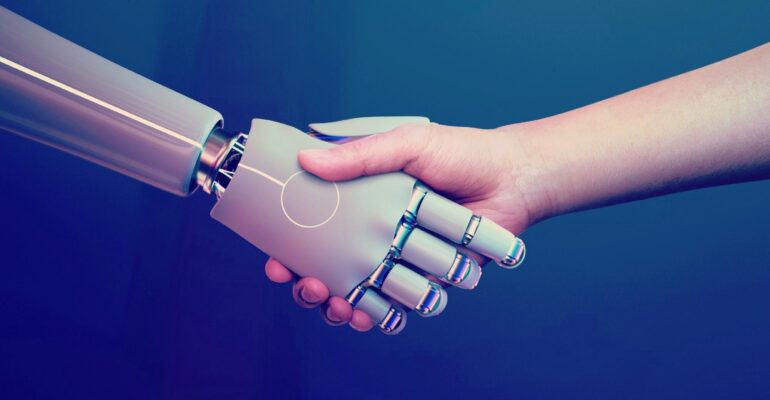Top 12 reasons Small Business should invest in A.I. and M.L. now

Change is the only constant variable in today’s economy, and we need to embrace and adapt to excel. Those who embrace digital transformation will stand out from the competition. Below you will find the 12 significant changes happening within the supply chain. And COVID-19 accelerated the pace.
1) From traditional Supply chain to digitalization incorporating Machine Learning
Leadership is highly recommended to have an external consulting firm lead the corporate change. The reason is to avoid the emotional, cultural, historical and personal biases that interfere and put the project’s success at risk.
2) Pure fanatical cost savaging vs Digitalization
Incorporating ML will allow the company to gain strategic advantages that will bring these benefits:
a) Increase efficiency and productivity.
b) Allow the company to make better on-time decisions.
c) Improve supplier-customer satisfaction and long-term relationships.
d) Better employee satisfaction and talent retention.
e) Implement a socially responsible solution where everyone wins.
f) Will create a new collaboration model within the organization.
3) Supply Chains back to basics, from Global to Regional
Yes, the most expensive component is the one you don’t have in stock. The traditional sourcing strategy was cost-driven, and global sourcing was the proper answer for 20 years. COVID-19 challenges the status quo, and now most industries shift from global to regional or a combination of it.
4) From “Should I Outsource?” to “How much should I outsource?”
Outsourcing, Distribution, and Logistics — Product’s life cycle is shorter, and managing manufacturing and warehousing for components | goods and the finished product is unmanageable due to customer expectations demand. So the answer is what strategy solution can optimize and support the corporate goals.
The challenge for supply chain logistics is to balance cost and customer experience simultaneously; they need to handle real-time operations with new technology, the urgency to bring the product to the market, and end-to-end visibility that the current industry needs.
5) Heavily Manual workforce vs. Strong Analytics Skills
Implementing new technology will require many professional upskills to enhance visibility. The top three technologies that are becoming a priority in the supply chain industry are |Data analysis 41%, IoT 39%, and cloud computing 39%. Companies will need to embrace technology to be able to make on-time data-driven supply chain strategy decisions.
Today most supply chain professionals can’t take advantage of the data since they don’t have analytic capabilities because they are not statisticians or data scientists. With AI and ML, most professionals in this area need to be upskilled to provide value-add to and supervise the data entry, look for trends | patterns, and know what to do with it.
6) From WHQ to Remote and home Office
The new working model is a hybrid workforce (on-site and remote). The transformation of the traditional office space to a collaborative, innovative model will require re-evaluating the current office and workforce needs because the number of businesses adopting artificial intelligence grew by 270% in the last four years. As a result, the new office model will drive the creation of new jobs, and rather than replacing workers AI can be a tool to help employees work better and have a work-life balance in a fulfilling job. These changes will also increase the collaborative capabilities of the remote workforce from other countries, allowing them to be more integrated while increasing overall output.
“The effect of AI on jobs is totally, absolutely within our control,” Cathy Bessant, chief operations and chief technology officer, Bank of America, said in her Davos chat. “This isn’t what we let AI do to the workforce; it’s how we control its use to the good of the workforce.”
7) From Stores to Online Purchase
Consumers’ behaviors have changed; consumers were forced to stay home, buy online, and grew to like the convenience, so now they are more comfortable buying via the internet than visiting stores. Companies need to be creative to provide a great experience providing excellent delivery services, an easy return policy, and supply-chain needs to take this into consideration.
8) From profitable to a meaningful mindset
The Supply chain team will need to be more purpose-driven, not only what they are buying, but why they do what they do and that requires a corporate cultural change. Companies that are not meaningful in their choices and decisions may find themselves alone and ostracized by the market because the existence to increase the shareholder profitability is no longer enough.
9) Highly confidential contracts vs. Real Transparency
Blockchain Technology will change the way of doing business with total on-time actual data, but this needs the proper preparation and guidance to avoid a more significant problem
10) Total quality vs. warranty service
Today, companies need to focus on cost and customer satisfaction by having products available since every product is easily exchanged in today’s highly competitive market. Quality products are not an option but a given, now a great customer experience (pre, during, and after purchase), with a simple purchase, fast delivery, 24/7 support, and warranties for total satisfaction, are not an option but the requirement.
11) From Bias (Diversity and Inclusion) to Protecting the Human Rights
Ensuring regulatory compliance, more and more organizations are incorporating the use of AI (Artificial Intelligence), ML (Machine Learning), and RPA (Robotics Process Automation). Still, they will need the burgeoning RegTech (regulatory technology) to help integrate the new solutions with the legacy platforms while developing methods that ensure bias is not built into the base functioning of the solutions. This will need the support of new regulations and compliance certifications
12) From fear and technology intimidation to embrace progress
There is still a lot of work to do in this regards, people is afraid of A.I. taking their jobs. According to CNBC/SurveyMonkey Workplace Happiness survey, “The survey found that 37% of workers between the ages of 18 and 24 are worried about new technology eliminating their jobs. That’s nearly 10% higher than any other demographic.”


